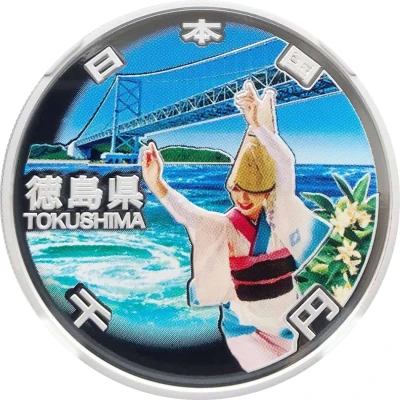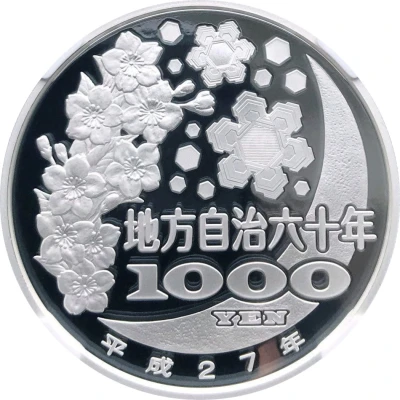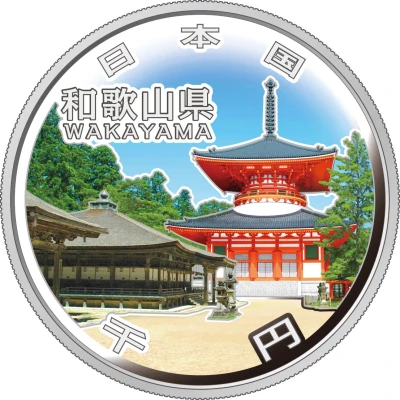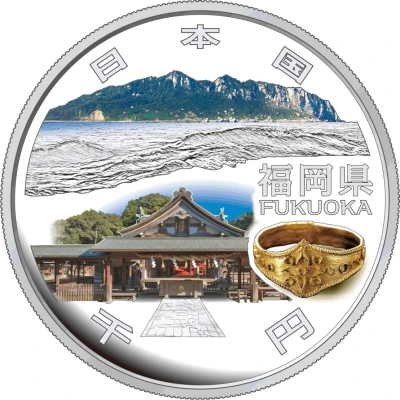
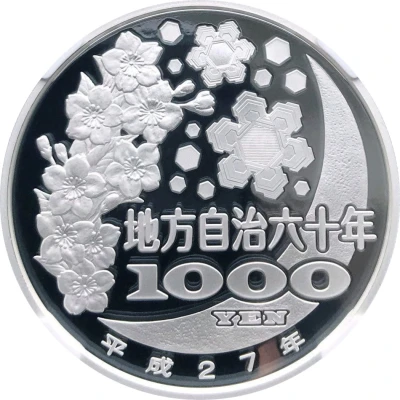

Obverse © Japan Mint – Reverse © coinsupermarket2012
1000 Yen - Heisei Fukuoka
27 (2015) year| Silver (.999) | 31.1 g | 40.0 mm |
| Issuer | Japan |
|---|---|
| Emperor | Heisei (1989-2019) |
| Type | Non-circulating coin |
| Year | 27 (2015) |
| Calendar | Japanese - Heisei era |
| Value | 1000 Yen 1000 JPY = USD 6.72 |
| Currency | Yen (1871-date) |
| Composition | Silver (.999) |
| Weight | 31.1 g |
| Diameter | 40.0 mm |
| Thickness | 3.5 mm |
| Shape | Round |
| Technique | Milled, Coloured |
| Orientation | Medal alignment ↑↑ |
| Updated | 2024-10-06 |
| Numista | N#123691 |
|---|---|
| Rarity index | 85% |
Reverse
Cherry blossoms, crescent and snowflakes.
Latent images in largest snowflake.
Lettering:
(47/60)
地方自治六十年
1000
YEN
平成27年
Translation:
60 years of local autonomy
1000
Yen
Year 27 of Heisei
Edge
Slanted reeding right
Comment
Okinoshima Island is a solitary island remotely located in the Sea of Genkai, where national rituals were performed between the late 4th century to the end of the 9th century to pray for the success of diplomacy and safety of navigation. Called the “Shoso-in (Treasure House) of the Sea,” this island is home to 22 ancient ritual sites that are well preserved. Here, about 80,000 artifacts, which had been used as ritual offerings, were unearthed, and all were designated as National Treasures.Munakata Taisha Grand Shrine is a combination of three Shinto shrines: Okitsu-miya Shrine on Okinoshima Island, Nakatsu-miya Shrine on Oshima Island and Hetsu-miya Shrine on Tashima. These shrines are devoted to three goddesses who were believed to protect the sea route to the Korean peninsula. The main hall and worship hall of Hetsu-miya Shrine are National Treasures.
A gold ring is one of the artifacts unearthed on Okinoshima Island. Similar rings were discovered in the royal tombs of Silla in Gyeongju, Korea, which implies that this ring was brought from the Silla Kingdom during the Three Kingdoms period of Korea. The ring was designated as a National Treasure in 1962.
Interesting fact
The 1000 Yen - Heisei (Fukuoka) 27 (2015) coin from Japan features a unique design that showcases the country's rich cultural heritage. The obverse side of the coin depicts a stunning image of the Fukuoka Tower, a prominent landmark in the city of Fukuoka, while the reverse side features a beautiful representation of the Japanese pheasant, a symbol of good luck and prosperity in Japanese culture. The coin's design is a testament to Japan's rich history and cultural traditions, making it a highly sought-after collector's item for numismatists and enthusiasts of Japanese culture.
Price
| Date | Mintage | VG | F | VF | XF | AU | UNC |
|---|---|---|---|---|---|---|---|
| 27 (2015) | 100000 | - | - | - | - | - | - |
Values in the table are based on evaluations by sales realized on Internet platforms. They serve as an indication only for 1000 Yen - Heisei (Fukuoka) 27 (2015) coin.
